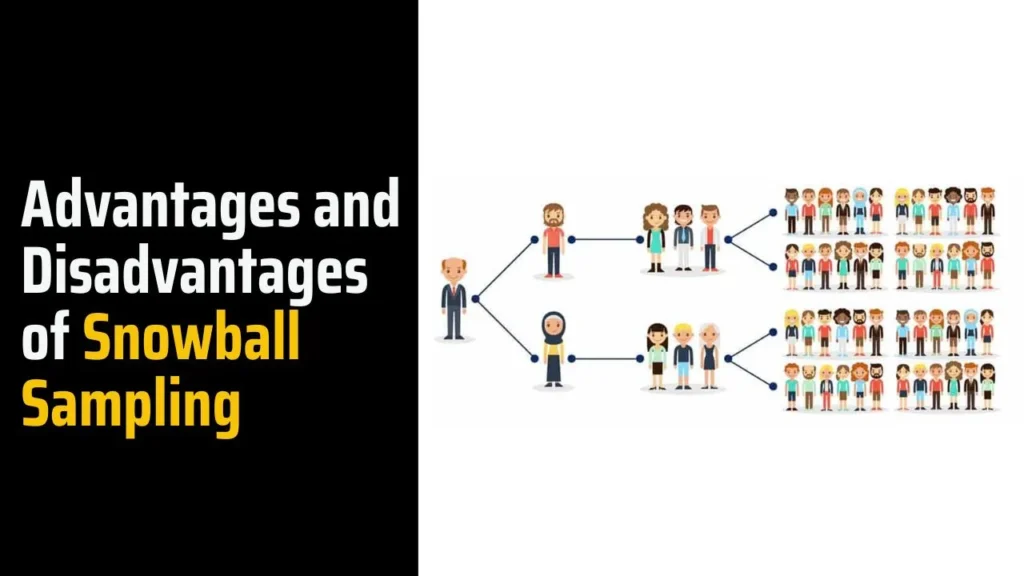This article delves into the advantages and disadvantages of snowball sampling, a non-probability technique beneficial for studying hard-to-reach populations, a Snowball sampling, also known as chain referral sampling.
Snowball Sampling
Snowball sampling, as defined by Oregon State University (2023), is a recruitment method where research participants are asked to help identify additional potential participants.
Initially, researchers find their first participants, who then refer further potential participants themselves (Jones & Gratton, 2009).
Snowball sampling is a method for researchers to gather a substantial number of individuals’ opinions. This is achieved by initially identifying a few people and then asking them to refer others for study.
Researchers following the snowball sampling technique, as outlined by Saunders et al. (2007), must follow these steps:
- Initiate contact with one or two cases (research participants) within the population.
- Request these cases to identify additional cases.
- Ask the newly identified cases to identify further new cases, continuing this process.
- Stop when there are no new cases provided, or when the sample size is as large as becomes manageable.
For instance, if you’re investigating customer satisfaction within an exclusive country club, gathering primary data can be challenging unless a club member agrees to connect you with others.
This method relies on initial participants referring additional potential participants, forming a chain of referrals for the research. Hence, it’s also known as chain-referral sampling.
Snowball sampling is widely used in business studies, especially when the population is scarce or unknown, making it difficult to select subjects for research samples. The process can continue, akin to a snowball growing larger, until there’s enough data for analysis and informed decision-making by organizations.
The snowball Sampling Process
The snowball sampling process starts with identifying a few initial participants, often called ‘seeds’ or ‘gatekeepers.’ These individuals are chosen for their relevance to the research topic and their potential to offer valuable insights.
Once these initial participants are interviewed, researchers ask them to recommend others who meet the research criteria. This iterative process continues until the desired sample size is achieved or until data saturation is reached or sample size is achieved, indicating that new participants no longer contribute to additional information.
Advantages of snowball sampling
1. Good for exploratory research
Snowball sampling can be good for exploratory research because it enables researchers to investigate populations that have received limited study in the past.
2. Cost Efficiency of Snowball Sampling
Snowball sampling offers a cost-effective approach. Unlike traditional sampling methods that require significant resources for participant identification and recruitment, snowball sampling relies on the networks and referrals of current participants, making it a more efficient and economical option.
3. Generating Diverse Data
Snowball sampling can generate diverse and comprehensive data. As participants refer others, the sample size expands and encompasses a range of demographics, perspectives and experiences. This diversity contributes to a deeper comprehension of the research subject.
4. Accessing Hard-to-Reach Populations
Snowball sampling facilitates access to populations that are typically difficult to reach, such as marginalized or hidden communities. Leveraging existing connections enables researchers to tap into the trust and rapport established within these communities, enhancing participation rates.
Disadvantages of snowball sampling
1. Sample Bias in Snowball Sampling
Snowball sampling’s major drawback is the risk of bias in the sample. As participants are brought in through referrals, the sample may not accurately represent the entire target population. This can skew results and limit their applicability. Researchers must acknowledge this bias and interpret findings accordingly.
2. Dependence on Social Networks
Another issue is the heavy reliance on existing social networks. If initial participants lack diverse connections, the sample may lack variety and be too homogeneous. To address this, researchers should carefully choose initial participants to ensure diversity among participants.
3. Lack of Statistical Sense
Parker et al. (2019) note that snowball sampling, although convenient, lacks the statistical rigor of random sampling. This technique is often criticized for not meeting the criteria of true random samples, particularly in quantitative research. Qualitative researchers tend to use snowball sampling more frequently than quantitative researchers.
4. Challenges in Estimating Sampling Error
Estimating sampling error or determining statistical significance can be challenging with snowball sampling due to its non-probability nature.
5. Reduced Generalizability
Snowball sampling, due to its reliance on referrals within participants’ networks, may lead to a sample that lacks representativeness of the larger population, limiting the generalizability of findings.
Alternative Sampling Methods
Although snowball sampling has its merits, researchers should explore alternative sampling methods based on their specific research goals. Convenience sampling, for instance, can be an option when resources or time are constrained. This approach involves choosing participants based on their easy accessibility, which may introduce bias but can serve well in exploratory or preliminary studies.
Ethical Considerations in Snowball Sampling
Ethics are paramount in research, including snowball sampling. Researchers must prioritize protecting participants’ rights and well-being throughout the data collection process.
Here are key ethical considerations for snowball sampling:
- Minimizing Harm: Take steps to minimize potential harm or distress to participants during the research, prioritizing their well-being at all times.
- Informed Consent: Obtain clear, informed consent from participants, outlining the study’s purpose, data collection methods, and potential risks and benefits. Participants should be able to withdraw from the study without repercussions.
- Confidentiality and Anonymity: Ensure participants’ identities and responses are kept confidential and anonymous. Use coding systems to safeguard privacy and prevent inadvertent disclosure of sensitive information.
Conclusion
Snowball sampling offers distinct advantages for data collection, especially when studying hard-to-reach or elusive populations. Its benefits include accessing marginalized groups, cost-effectiveness, and potential for diverse data. However, researchers must also acknowledge its drawbacks like sample bias and reliance on social networks.
While snowball sampling has become popular in social science and qualitative research, its suitability depends on the research goals, target population, and study context. Researchers should carefully weigh its strengths and limitations to determine its appropriateness for their research endeavors.



